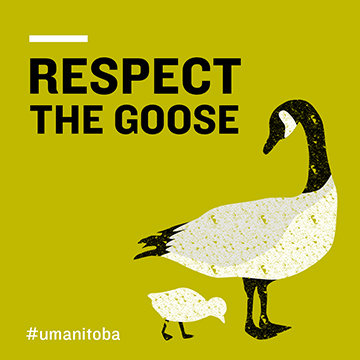
Why did the goose cross the road?
Drive cautiously during gosling season
Geese will take their family to areas that they perceive to be important to their survival, says Jim Shapiro, director of the Avian Behaviour Laboratory in the U of M’s department of psychology, Faculty of Arts.
“A mated pair of geese will take their goslings to areas they consider safer, better or more supportive of their dietary and protective needs. None of these objectives is the result of a conscious decision. The parents are responding to environmental stimuli that are important to them and have no idea of how dangerous vehicles can be.”
Geese will cross a road without respecting the vehicles traveling at high rates of speed on the road they are trying to cross, he notes. Anyone coming onto campus or leaving via residential streets is cautioned to drive with care, and to allow geese to cross the roadways as they move around campus.
“We want to alert the campus to is the possibility of having a family of geese with goslings appear suddenly in front of them as they are driving on campus,” Shapiro adds.
Don’t interfere, even if it seems like you could help
As the goslings hatch, staff and students may notice them on rooftops or other apparently unsuitable areas. Physical Plant staff have consulted with Environment Canada experts and the U of M Avian Behaviour Laboratory for advice on how to manage the hatching process. Our wildlife and geese population plan is also informed by Manitoba Conservation, Environment Canada and the U of M Avian Behaviour Laboratory.
With regard to the goslings appearing on campus, please note:
- Goslings have a three-day supply of food within them to provide them with nutrients after hatching.
- Goslings are light and can withstand a jump from a rooftop of up to eight stories without injury.
- The parent geese take the goslings to water and food as necessary.
- In extreme cases where goslings require assistance, MB Wildlife Branch will be contacted by Physical Plant.
Staff and students are reminded that they should avoid interfering with the geese and avoid feeding them.
The geese are likely in their final stages of nesting, so please remain extra cautious, avoid nesting areas and keep a wide berth. Once goslings are hatched, most geese will move on from campus.
Under no circumstances should staff or students attempt to access rooftop areas to provide assistance to geese.
If there are concerns with a goose or goslings in an area, contact Physical Plant at 204-474-6281 or email: goose [at] umanitoba [dot] ca
Physical Plant will coordinate appropriate services.
Also see our interactive goose nesting map, which can be used to plan your exterior route on campus as to not disturb nesting geese.
If you see a nest not on our map, please report it to goose[at]umanitoba[dot]ca or 204-474-6281.
Respect the Goose Series
 For other facts and tips on geese, goose behaviors and successfully cohabitating on campus, see more of our “Respect the Goose” series.
For other facts and tips on geese, goose behaviors and successfully cohabitating on campus, see more of our “Respect the Goose” series.
Mar. 21, 2018: Geese who’s back? Cohabiting with campus wildlife
Apr. 4: Can’t we all just goose along? Tips, dos and don’ts
Duck, duck, goose: What to do if you encounter a goose
Apr. 17: Geese are part of our community: Article by Dr. James Shapiro
Apr. 25: Take a gander: Check out our interactive nests map to plan your route
In Focus: http://news.umanitoba.ca/category/respect-the-goose/
You can also follow us on social media here: https://twitter.com/umanitoba #respectthegoose






